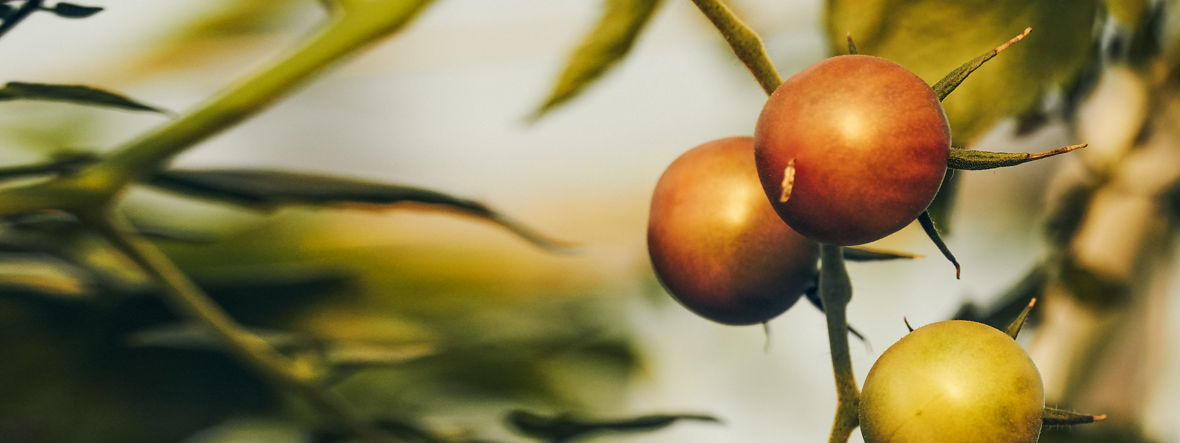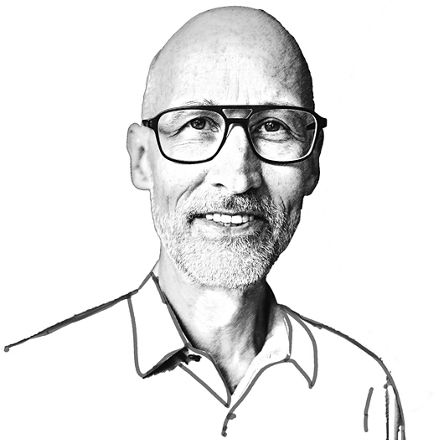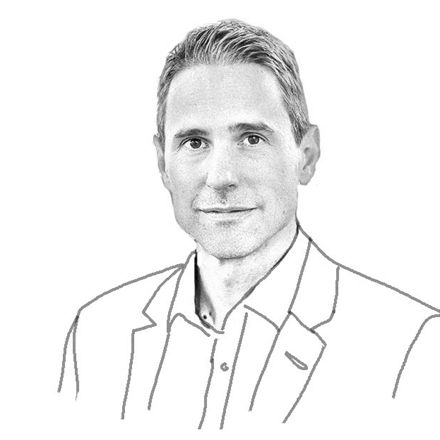The glass towers of the major banks in Frankfurt can be seen on the other side of the Main River. In the glass greenhouses of the cooperative on the river’s southern bank, the aim is the same: growth. But here it’s not about assets—it’s all about tomatoes and Swiss chard. On five hectares, the cooperative produces vegetables for its members, in line with the standards of the organic agriculture association Naturland. Almost 500 people from the region are members; some of them lend a hand here as well. This is where we meet Felix Prinz zu Löwenstein, who has an organic farm of his own in southern Hesse, for a talk.
In the Fridays for Future demos, hundreds of thousands of people are taking to the streets to demand protection for the climate—and a more sustainable approach to nutrition. Are you gratified by this development?
Agriculture too must help to achieve the climate goals. We knew that even before the demos. In Germany alone, we need to reduce our carbon dioxide emissions by 13 million tons per year. Unfortunately, our politicians lack the courage to make a real change. Above all, we need to reduce the input of nitrogen and nitrates into our ecosystems, for example by significantly reducing livestock density—but people don’t dare to do that.
What needs to happen in order to change producers’ and consumers’ behavior?
The policymakers must create a framework in which the prices of different foods reflect the true costs of their production. For example, the horn shavings that we use as a natural fertilizer in organic agriculture cost between three and four euros per kilogram of nitrogen. Conventional nitrogen fertilizer can be bought for as little as one euro per kilo. However, its true costs, which include the costs resulting from the pollution of groundwater and the atmosphere, are considerably higher. The same principle applies to chemically synthesized pesticides. However, it would be naïve to expect broad segments of the population to go to the trouble of analyzing these external costs. This is where policymakers need to act.
The German government has declared that in the future a price will be put on greenhouse gas emissions in agriculture…
Yes, ten euros per ton. That’s a joke.
In your opinion, what are the most effective measures that must be implemented today?
In Europe the EU’s Common Agricultural Policy must be restructured. Every year, the EU distributes €55 billion to agricultural enterprises—that’s 16 percent of their gross value added. At Evonik, a financial backer as important as this would be influencing corporate policy. But in the field of agriculture, the European Union is not exerting any influence on corporate policy. Instead, 80 percent of the funds are distributed in line with the “watering can” principle, according to how many hectares of land are under cultivation. The funds should be used to pay farmers for the work they do that is needed by society, but that the market does not pay them for.
For the conservation of fruitful soil, for example?
Exactly. The second measure is a change in the EU’s trade policy. The new President of the European Commission, Ursula von der Leyen, recently said she could imagine charging import duties at the EU’s external borders in order to balance out the differences between the environmental effects of various products. That was a good proposal, and it also conforms to the rules of the World Trade Organization, the WTO. Among other things, that would raise the price of soybeans, through which we’re importing lots of nitrogen emissions from overseas. The third measure is the further development of organic farming. We must do more research in this area so that it can become the right path for everyone.

At the end of 2017, almost 70 million hectares of land worldwide were devoted to organic farming. According to the Research Institute of Organic Agriculture (FiBL) and IFOAM—Organics International, that amounts to about 1.4 percent of all agricultural land. This percentage has recently been growing by 20 percent annually. The largest areas of organic farmland are in Australia (35.6 million hectares), Argentina (3.4 million hectares), and China (3 million hectares). Organic farming operations commit themselves to basically avoiding the use of synthetic pesticides and herbicides, mineral fertilizer, and green genetic engineering. In animal husbandry, some types of feed are prohibited, and the required minimal amount of space per animal is defined more generously. Before an operation can market its products as “organic,” it must go through a transitional phase lasting several years, as a rule. In the European Union, the concept of “organic” is protected by the EC Organic Regulation. Since 2010, products raised in accordance with this regulation can be labeled with the EU organic logo. In the USA, products must be certified by the Department of Agriculture before they can be labeled “organic.”

By 2050, it’s likely that agriculture will have to feed more than nine billion people on earth. In the face of this challenge, shouldn’t we be focusing more strongly on highly efficient mass production?
Of course we should produce as much food as possible—but not in ways that destroy the foundations of food production. Biodiversity is the foundation of plant production. If we destroy it, the fact that we used to have high yields won’t do us any good. The same thing applies to soil fertility and climate stability. If I burn a pile of straw, I’ll be nice and warm for a while, but after the straw has been burned up, I’ll feel cold pretty soon.

Organic farming offers good solutions, but it requires a lot of space. If we wanted to raise all the broiler chickens in Germany according to the rules of organic farming, half of the state of Hesse would have to be turned into open-air chicken coops. Is that what you want?
People often make the following simplistic argument: “If we were to do organic farming everywhere, we would produce less food. That’s why we need more space, so we’ll have to turn even the last nature reserve into farmland.” I hear this from people who haven’t paid any attention to market theory and who don’t know that altered prices change people’s consumption patterns. That applies especially to meat, whose production requires the largest proportion of land. The claim that “economies of scale” make it possible to produce more on large farms than on small ones is simply false. Today you can work more productively in smart small-scale farming than in a large agricultural enterprise. Between 50 and 70 percent of the world’s agricultural products are raised on farms that are smaller than two hectares. Especially in developing countries, farmers can cultivate small areas much more intensely than large-scale growers can. Industrial growers often force small farmers out of business and then use the land to raise fodder crops instead of food.
Many people reach for conventionally produced items on supermarket shelves because they are usually cheaper than the organically produced alternatives…
Yes, because the prices lie, and most of the real costs are being passed along to the general public or future generations. But we can’t afford to pursue social policies at the environment’s expense. It would be shortsighted to continue practicing agriculture the way we have done so far just to enable poor people to eat more meat. We would help poor people more if we stopped wasting 20 percent of our food on the way to the store and 30 percent more on the way to the consumer. Poor people are already suffering more than rich ones from the consequences of environmental damage.
Nonetheless, some people feel that urging people to buy more organic food is elitist. An organically raised chicken is delicious, but it costs €20.
If we start from the realization that our food budget is limited, we simply have to significantly reduce our meat consumption. A project in Denmark is demonstrating that this transition within a fixed cost framework actually works. The city of Copenhagen has ordered that 90 percent of the food served in all of its public canteens must be organic—and it has reached this target. The guests are well-fed, but less meat is being served and less food is being thrown away. As you can see, this discussion is not only about productivity.

Several startups have started to grow meat from the cells of chickens, cattle or pigs. Can this technology help to solve the problems connected with meat consumption?
We’d have to find out where the nutrient solution came from and how much energy was needed. This method might turn out to be more efficient than chicken breeding, and a chicken nugget might someday no longer cost €8,000.
It already costs less than $100 today.
All the same, I’m still skeptical—and I’m also skeptical about indoor production facilities where vegetables grow aseptically under artificial light. There’s a connection between the soil and the quality of the products that are grown in it. Winegrowers call it terroir. Human beings started to grow crops and breed animals 10,000 years ago, and since then we have continued to develop, together with our foods. Never before has our diet changed as much as it has in the last five decades. Many problems in our man-made environment have arisen because we have moved as far as we possibly could from natural relationships. So it might be wise to realign ourselves with natural systems and the ways they function.
Even if we want to have entirely organic nutrition, it would take many years to reorganize agriculture. Shouldn’t we direct all our efforts at making conventional food production as sustainable as possible?
Of course we have to reorganize agriculture in ways that enable it to cause less damage than it does today. For example, we shouldn’t accept the fact that today every pig is given antibiotics at least once in its life. We have to make sure that a chicken is once again treated like a chicken rather than a factory product. We need stable systems that do not constantly depend on external interventions. A small farmer in the Philippines who raises 90 different kinds of plants on one hectare has a completely stable system. We can learn a great deal from that.
»In 15 years we will no longer need any chemicals for removing weeds from our fields.«
Technologies such as precision farming that are being promoted by industry are benefiting organic farming as well as conventional agriculture.
That’s partly true. Agricultural engineering is in fact developing at a rapid pace, thanks to digitalization. I would wager that in 15 years we will no longer need any chemicals for removing weeds from our fields, thanks to improved mechanical methods. I’m personally very interested in this topic because of our cultivation of herbs and medicinal plants—they need to be raised in a completely weed-free environment. If you want to raise marigolds for skin care products, you don’t want to have poppies growing among them.

When it comes to protecting the environment, the human race is turning out to be capable of learning. For example, the hole in the ozone layer has shrunk because of the ban on CFC emissions. Are you hopeful that we can also get things moving in the area of nutrition?
We must create underlying conditions that prohibit people from producing cheap products at the cost of the general welfare. Things are already moving in this direction: Sales of organically produced food are already growing year on year by as much as ten percent. And ten years ago you would probably not have been able to find enough families in Frankfurt to set up a vegetable-growing cooperative.




